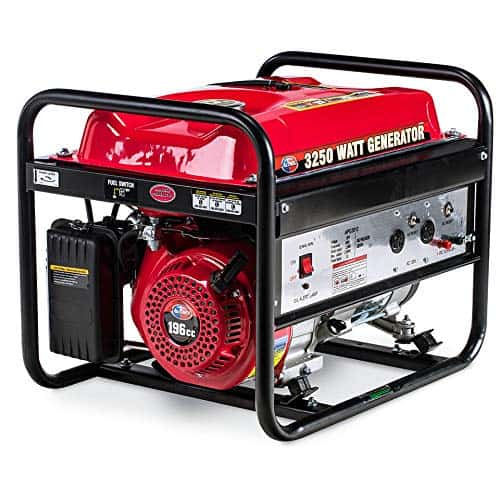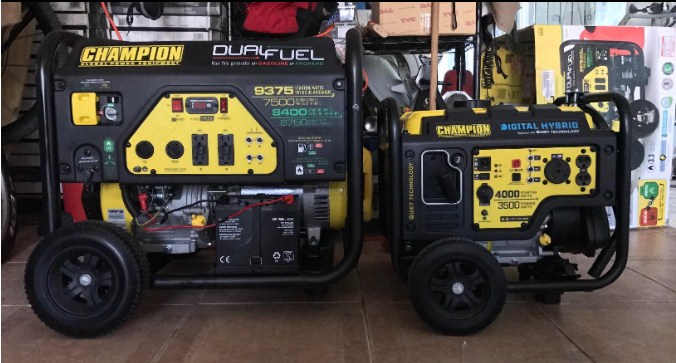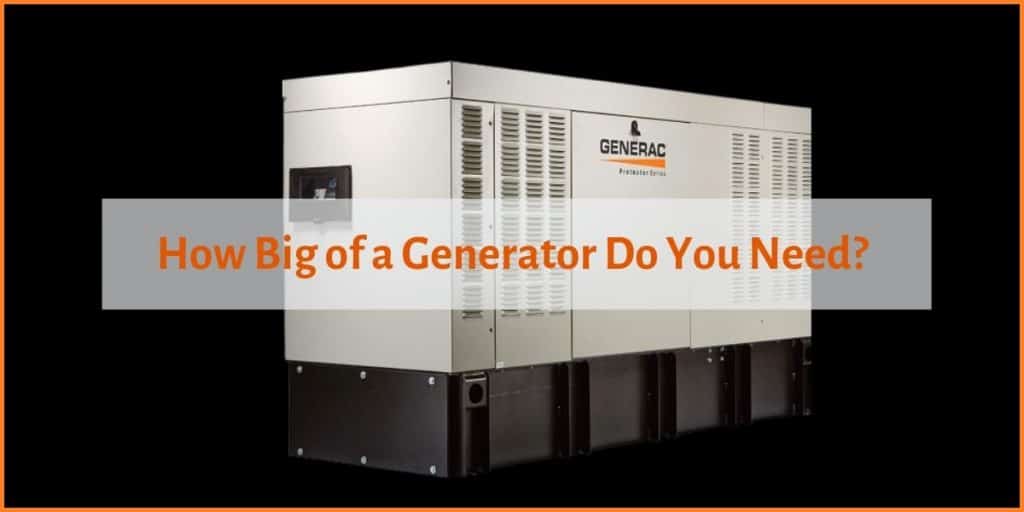How Big of a Generator Do You Need?
You are here probably because you have already decided to get yourself a generator. Great.
But it’s not over yet.
A common question we get from our readers looking for generators is, what size of a generator they need.
The answer to this question is not as straightforward as you would wish, sorry, and it depends on a plethora of factors.

Often, we see many people making the mistake of purchasing a generator and later come to regret, wishing they had considered the factors first. Let’s face it, a generator is an expensive investment, and you don’t want to waste your money on a unit that will not serve you.
That’s why you need to make careful consideration when choosing the ideal generator size.
Table of Contents
Generator Size: What Does That Mean?

When talking about generator size, we are not referring to the physical size, but rather, how much electrical power a generator can supply, which is measured in watts (W).
Why is the size of the essence?
Getting an improperly-sized generator is a costly mistake.
If you get one that is too small, you might end up getting insufficient voltage to power your appliances. Under-voltage is damaging to both your generator and appliances and can result in expensive repairs and even replacement.
On the other hand, get yourself a big generator, and you are essentially throwing money away by unnecessarily overpaying for the unit as well as the operation cost.
So, what should you do to get a generator that is sized for your needs?
Continue reading on our article below.
Determine your Power Needs
Of all the factors that influence the size of a generator you will get, power is the most integral factor.
Though we shall brief you about the other factors later, let us first look at how power will influence your generator size.
When determining the size of your inverter, you will need to calculate the watts you require to power your appliance. For example, if you are planning to power a refrigerator alone, you will need roughly 2000W. Therefore, if you are to buy a generator, you will need one with a power rating of 2000W.
But there is more to this;
Understanding Surge Wattage and Running Wattage
You have probably come across these two terms. Running wattage refers to the power needed to keep your appliance running.
Surge wattage, on the other hand, also referred to as the spike or maximum wattage is the power needed to startup your electrical appliance.
In most cases, the surge wattage is often higher than the running wattage.
Now, while your appliance will most of the time use the running wattage as the surge wattage is only required for a brief period during the short startup, understand that both of these metrics count when determining the size of your generator.
Let's take our refrigerator example above. To run your refrigerator, you will need 800W, which is continuous wattage. However, when starting this unit, you will require an additional 1200W, for the compressor to kick in.
This means that while 800W is sufficient to run your refrigerator, you will, in the first place, require 1200W extra watts to kick start your fridge.
Again, once your refrigerator is running, you can still factor the “freed” 1200W, since you will no longer be needing them. As such, you can get another appliance(s) with a surge output of less than 1200W.
Steps of Determining the Size of your Generator with Regards to Power
Make a List of All Your Items
The first thing to do is to make a checklist of all the items you will need to power in case of a power outage.
While the listing will depend on personal preference, the general ranking situation is based on this situation:
Lighting>refrigeration>Cooking> Entertainment>Heat>Cleaning.
Determine your Power Requirement
Assuming you have identified all the appliances that you will need to power, the next line of action is to determine the individual power requirements of each appliance.
Normally, you are bound to find the wattage requirements of the appliances in the identification plate or owner’s manual in the buyer’s kit of each electrical equipment.
At times, you might find the power requirements in amperes. To determine the wattage requirements, from amperes, you will need to convert the amps into Watts.
Use this simple formula to convert amps into watts:
Wattage= Amperes * Volts
Alternatively, you can use this power consumption chart listing of the common household appliances to determine how much energy you’ll need to power some of the common household appliances.
Add the Total Number of Wattage
Once you have determined the individual power needs of each appliance, the final step is to add the surge wattage of each appliance, and the total should provide you with the wattage requirements you’ll need for a generator.
Let’s Look at an Example
Assuming we have two homeowners; homeowner A and Homeowner B.
Homeowner A is the conservative type, only powering the essential items during a power outage. Here is a list of items powered by this homeowner A alongside their power requirements:
Appliance | Running Wattage | Surge Wattage |
|---|---|---|
2 Light bulbs | 100W@-Total of 200w | 200 |
Air conditioner | 3800 | 4950 |
Water heater | 4000 | 4000 |
Refrigerator | 800 | 2000 |
Laptop | 75 | 75 |
Microwave | 600 | 1700 |
Total | 9,475 W | 12,745 W |
If homeowner A is to get a generator, the ideal size would be a 13kW generator
Homeowner B
If you are like me, who does not hold back when it comes to power usage even during emergencies, you are probably looking to power your entire household.
Here is a list of items homeowner B powers:
Appliance | Running Wattage | Surge Wattage |
|---|---|---|
10 Light bulbs | 100W@-Total of 1000w | 1000 |
25" color TV | 150 | 150 |
Clothes Dryer | 1000 | 4000 |
Coffee maker | 800 | 1400 |
Dishwasher | 1200 | 1500 |
Electric Heater Fan | 2000 | 3000 |
Central AC | 3800 | 4950 |
Total | 9,950W | 16,000W |
If homeowner B is to get a generator, he would probably need a 17Kw generator.
Understand that the above metrics will only provide you with a rough estimate of your wattage requirement and to be on the safe side, we always encourage our readers to add 20% of the wattage they get from their compilation.

